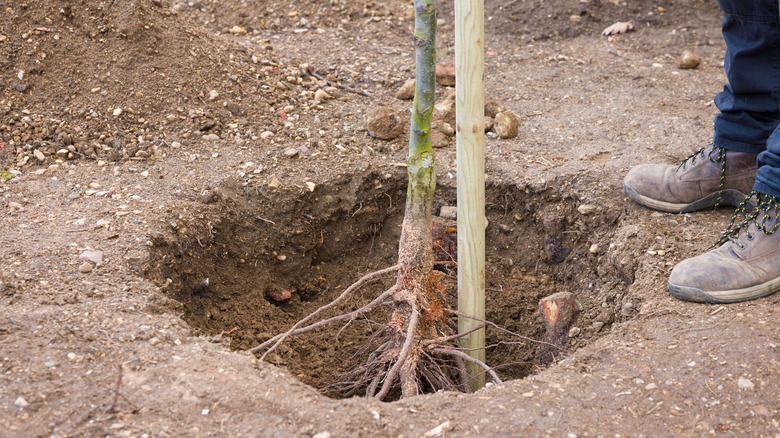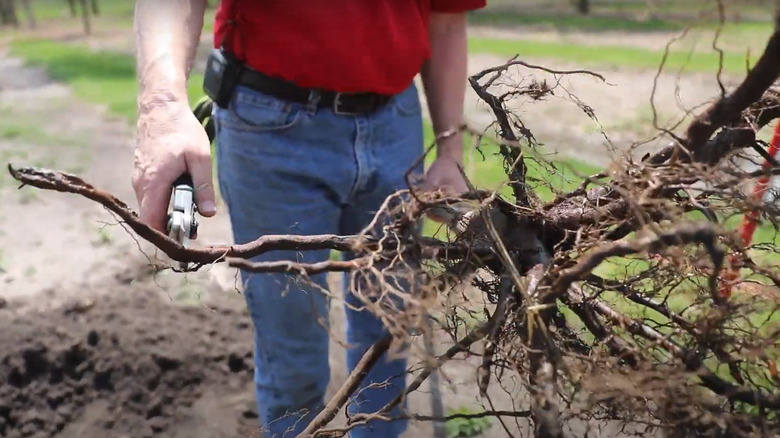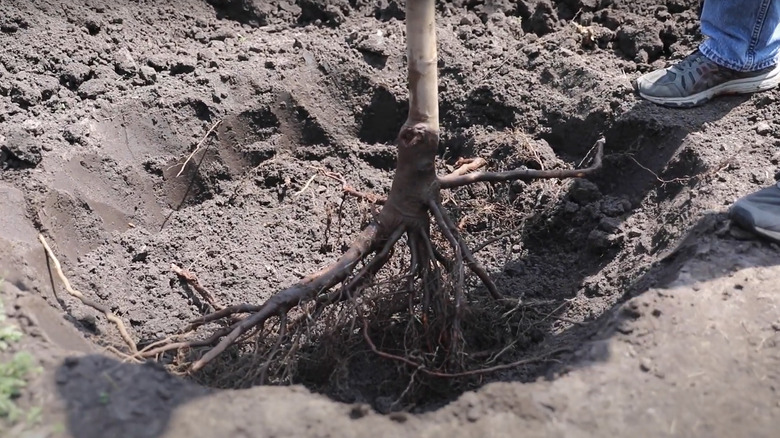The Best Method For Planting Bare Root Trees In Your Yard
Bare root trees — trees sans soil around their root system — are ideal for gardeners seeking economical landscaping choices. The lack of soil makes excavating, transporting, and storing easier, significantly reducing the cost for putting up a windbreak or a privacy hedge. Plus, they cut down on the growth time required for starting from seeds while making girdled roots unlikely — a scenario more common in potted trees. But the bareness also means that the roots are exposed to several environmental stressors, such as heat, drying winds, and cold. So, ensuring the roots establish themselves fully is pivotal for the bare root tree to thrive. To do so, dig out a hole wider than the root system's current reach so the roots can spread out unhindered.
Place the bare root tree no deeper than its root flare — the point where the tree's trunk begins opening out to roots. Don't mistake it for the scar from a graft union (joining of the scion and the root), usually found 1 to 3 inches atop the root flare. This will allow the roots to breathe and ease poor drainage issues. It's best to plant dormant trees, without buds and leaves. In evergreens, signs of dormancy include the top foliage turning tan.
Planting considerations
The successful establishment of bare root trees depends heavily on their condition. While they don't come balled and burlapped, their roots are covered in sphagnum moss or hydrogel for protection. But the material shouldn't be too wet or drippy, or it'll cause premature rotting. Ideally, the roots should be thick, dense, and firm, with no signs of frost or mold damage — although you should prune dead or damaged roots before planting. The point is not to overdo it, as trees need a good root system to flourish.
If the trees do have buds, ensure they're green and sturdy. Also make sure the tree has a straight, well-established leader (stem) and dense branch structure covering at least two thirds of the tree, especially at the ground end. This is because the lower branches provide the food necessary to grow the stem and the roots. Favor trees that aren't too tall — ranging between 4 and 7 feet with an inch-wide stem taper — as their roots are easier to accommodate. Avoid ones that smell foul, as they're most likely diseased.
If they're in good condition, plant bare root trees immediately if possible. If rain's coming or you want to wait out for a while, store the trees with their damp packing in frost-free areas, like a cellar or a garage, where mercury hovers at about 40 degrees Fahrenheit. Cover the trees in slightly wet newspapers if you purchased them without protection.
How to plant bare root trees
For the best results, plant bare root trees early in spring when they're yet to leaf out; otherwise, heat or winds might damage them before they're deeply rooted. However, winter planting is okay if the ground remains unfrozen. Choose your planting location after factoring in the tree's eventual size and how it will fit in the yard's layout. The soil in your selected spot should drain well. If it has grass, remove the grass and till the soil to break down any leftover roots. Next, unpack the tree and soak its roots in water for one to four hours.
Prune dead roots and dig a hole at least large enough for the roots to fit in easily — leaving an additional 2 feet is better so the roots have ample space to spread. Dig deep enough for the tree's root flare to be at ground level; you can check this by laying your shovel across the hole to mark where ground level will be and line the root flare up with its handle. To avoid compressing the roots, build a conical soil mound for support before placing the tree in the hole. Fill the previously dug out soil back into the hole and lightly tamp it. Water the tree deeply (and repeat the process every week or 10 days). Spread 2- to 3-inch-thick mulch around your tree's base to keep weeds out and improve moisture retention. Stake longer trees in the first year of planting and remove the stakes the following spring.


